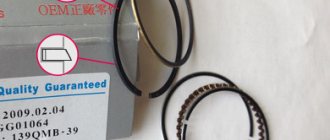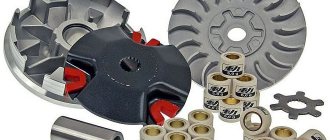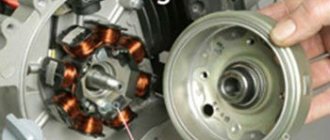Tire size
It is better to choose the tire size specified by the manufacturer. However, some models allow you to install larger tires, and this can sometimes be very useful.
The rear wheel of the scooter takes on the main load while moving. Accordingly, the larger the contact patch with the road, the higher the stability of the scooter, but this is one of many indicators that must still be met. Naturally, if the model of your scooter allows you to install a rear tire wider than the nominal one, this is worth doing. You need to prepare for the fact that after such a replacement, gasoline consumption will increase slightly and dynamics will decrease, because the resistance to the road surface has increased.
Wheel functions
The wheels of a vehicle play a very important role in safe movement, especially when it comes to any two-wheeled motor vehicles, in particular scooters. After all, worn out tire tread, deviation of tire pressure readings from the norm, as well as any other more serious malfunctions can lead to serious consequences that sometimes cost a human life. Therefore, wheels should be given no less close attention than all other components and assemblies of the scooter.
Scooter wheels must perform the following functions:
- ensuring good grip between the vehicle and the road surface;
- dampen shocks and vibrations while driving;
- carry out full transmission of traction and braking forces created by the scooter.
When we talk about wheels, we mean absolutely all their components and characteristics - tires, wheels, size, type, material of manufacture, etc.
First of all, I would like to say about tires, on which many scooter riders, especially beginners, often try to save money. In this regard, used tires are purchased, which can result in troubles on the road. It is worth noting once again that good tires are one of the fundamental aspects of safe driving.
The tire provides a level of riding comfort as well as maneuverability of the scooter. Thus, used tires can cause accidents, which will entail much higher costs than purchasing new tires in the first place. In appearance, used tires may be ideal, however, this is not a sign of its integrity and quality, since the naked eye can easily not notice minor damage, cord deformation, microcracks in the rubber that violate the tightness of the product.
All this can lead to an unexpected tire rupture while driving, which entails negative consequences. Thus, the real savings when purchasing tires can be achieved by brand. After all, the more famous the company that produces tires, the more expensive they are.
Scooter tires
Every time, before snow falls or melts, the owner of the equipment is faced with the question of how to choose tires for a scooter. Motorcycles and scooters have only two wheels, so special attention should be paid to the quality and condition of tires compared to a car. This article will tell you what to consider when choosing tires for a scooter. Most of this article is suitable for both motorcyclists and motorists, since the main characteristics of all tires are similar.
The first thing you should pay attention to is the seasonality of tires. All tires are divided into summer, winter and all-season. In principle, there is no special wisdom here - the names speak for themselves. You simply cannot use out-of-season tires on a motorcycle or scooter. Summer tires become hard in cold weather, while winter tires in warm weather are too soft and wear out quickly. Although all-season tires for scooters seem practical, it is better to avoid using them. Average indicators will not give good grip on the road surface either in winter or in summer.
Tires can be tubed or tubeless. Here, too, no special explanation is required. It is believed that in the event of damage, a tubeless tire can be fitted with a tube, but this cannot always be done. The tire for installing the camera in it must have a special internal tread for good adhesion to the camera. If there is no such tread on the tube, then the tire will quickly wear out. Well, tubeless tires should only be used with wheels specially designed for such tires. Otherwise, the wheel may randomly disassemble while driving, which can lead to tragic consequences.
By design, tires are divided into radial (RADIAL-TYPE), diagonal (BIAS-TYPE) and mixed, having an additional stiffness belt (BIAS-BELTED). The latter are used only for motorcycles and special equipment. The cords in radial tires are located along the radius of the wheel and do not intersect. They are stiffer, less susceptible to deformation at high speeds and have a more stable contact patch with the road surface. Also, radial scooter tires have lower rolling resistance and reduce fuel consumption. Radial tires are commonly used on motocross and sports motorcycles and scooters. In bias-ply tires, the cords intersect in pairs. They are easier to produce and, as a result, cheaper. It is rational to use such tires on off-road and roads with potholes, because... they are better at reducing shock loads. At the moment, radial tires for scooters and motorcycles have practically replaced diagonal tires.
When choosing a tire for a scooter or motorcycle, the tread pattern plays an important role. Basically, if we do not consider various subtleties, we can say that the tread pattern is designed in such a way as to remove water from the surface of the tire at the moment of contact with the road surface. A larger number of tread grooves performs this role better. Therefore, if you are the owner of a touring or cruiser motorcycle and travel frequently, take care of a sufficient number of grooves. For sports motorcycles or for riding only on dry pavement, tires with fewer grooves are better suited to increase the total area of contact between the tire and the road, which will improve the tire's grip on the surface of the pavement.
In conclusion, we will consider the main symbols and markings used on tires. The figure shows the location of the designation elements used on tires. Depending on the manufacturer, the arrangement of the elements may vary slightly. Let's look at some notations in more detail. The tire model indicates the conditions in which the tire can be used. Each manufacturer has its own model names, so there is no point in indicating them. More information about the models of each manufacturer can be found on the corresponding websites. Often the name provides more information for selection depending on operating conditions than standard designations. Therefore, if you are a fan of a particular brand, check out the features of the models on the manufacturer’s website before purchasing.
The next important characteristic is tire size. The first number indicates the width of the tire in millimeters, the second (through a fraction) the profile height as a percentage of the width. The tire width must match the rim size. Next, the marking indicates the tire design: “R” - radial (and not radius, as many people think); “–” — diagonal; “B” - diagonal with an additional stiffening belt. The next number in the marking is the rim diameter. Explanation of the last two indicators: load index (at maximum internal pressure) and speed index are indicated in the tables below. Failure to comply with these indicators can result in rapid wear and even deformation or rupture of the tire.
Tire Speed Index Table
| Speed index | Max speed, km/h | Speed index | Max speed, km/h | Speed index | Max speed, km/h |
| A | 40 | L | 120 | H | 210 |
| B | 50 | M | 130 | V | 240 |
| C | 60 | N | 140 | W | 270 |
| D | 65 | P | 150 | Y | 300 |
| E | 70 | Q | 160 | WR | >210 |
| F | 80 | R | 170 | ZR | >240 |
| G | 90 | S | 180 | (W) | >270 |
| J | 100 | T | 190 | Z | >300 |
| K | 110 | U | 200 |
Tire load index table
| Load Index | Max weight, kg | Load Index | Max weight, kg | Load Index | Max weight, kg |
| 1 | 46,2 | 21 | 82,5 | 41 | 145 |
| 2 | 47,5 | 22 | 85 | 42 | 150 |
| 3 | 48,7 | 23 | 87,5 | 43 | 155 |
| 4 | 50 | 24 | 90 | 44 | 160 |
| 5 | 51,5 | 25 | 92,5 | 45 | 165 |
| 6 | 53 | 26 | 95 | 46 | 170 |
| 7 | 54,5 | 27 | 97,5 | 47 | 175 |
| 8 | 56 | 28 | 100 | 48 | 180 |
| 9 | 58 | 29 | 103 | 49 | 185 |
| 10 | 60 | 30 | 106 | 50 | 190 |
| 11 | 61,5 | 31 | 109 | 51 | 195 |
| 12 | 63 | 32 | 112 | 52 | 200 |
| 13 | 65 | 33 | 115 | 53 | 206 |
| 14 | 67 | 34 | 118 | 54 | 212 |
| 15 | 69 | 35 | 121 | 55 | 218 |
| 16 | 71 | 36 | 125 | 56 | 224 |
| 17 | 73 | 37 | 128 | 57 | 230 |
| 18 | 75 | 38 | 132 | 58 | 236 |
| 19 | 77,5 | 39 | 136 | 59 | 243 |
| 20 | 80 | 40 | 140 | 60 | 250 |
The letter “F” or the words “Front Wheel” or “Front Wheel Only” after the size means that the tire is intended for installation on the front wheel only. The inscription “Rear Wheel” means that the tire can only be installed on the rear wheel.
The word "Rotation" with an arrow or just an arrow indicates the direction of rotation. If the arrow is missing, then the tire can be installed as desired.
"TT" or "Tube Type" means the tire is intended for use with a tube only. The words “TL” or “Tubeless” indicate tubeless tires. The tightness of such tires is ensured by a layer of special rubber on the inner ring, and the special design of the rim allows such tires to be securely fixed. If you are going to use tubeless tires, make sure your rims are designed to handle tubeless tires.
The maximum permissible air pressure in a tire is specified in kilopascals (kpa) and pounds per square inch (pci). The maximum load is indicated in kilograms (KG) or pounds (LBS).
Other bus parameters indicated in the figure are intuitive; there is no point in describing them here. The designations of various conformity marks have similar parameters; if you are interested, information can be found on the Internet.
How to choose wheels for a scooter
When choosing tires for a scooter, you should pay attention to:
- Tire expiration date. Strange as it may sound, the tire is suitable for safe use for 4-5 years; after this period, the rubber begins to harden, gradually losing its elasticity. Accordingly, if the tire was manufactured relatively recently, it will last much longer.
- For marking. Depending on what time of year the scooter will be used, you should purchase the appropriate tires. As a rule, the reference point is the average daily temperature, when it drops below a certain level, you should choose a different type of tire.
- To the frequency of the groove network. The grooves serve to drain water from the traction patch, which ensures safe driving in the rain.
Tire classification
There is also a classification of tires into classes and design. Regarding the latter, tires can be tubed or tubeless. Each class has its own pros and cons. According to experienced scooter riders, tubeless tires are better and more reliable, since in case of a puncture, which happens unexpectedly and is dangerous at high speeds, they are able to hold air for some time, which allows them to get to a service station to replace the damaged wheel. However, tubeless tires require special rims, which involve additional expenses.
In short, replacing a tire is the most common and common reason that requires removing a wheel on a scooter. By and large, there is nothing complicated in this process if you have the necessary tools at hand, a little perseverance and patience, and also know the sequence of actions that need to be performed.
Table. Correspondence to motorcycle tire sizes and decoding of abbreviations.
| Tire size in inches | Tire size metric | ||
| 100 | 90 | 80 | |
| 2.75 | 80/100 | 80/90 | 90/80 |
| 3.00 | 90/100 | 90/90 | 100/80 |
| 3.25 | 100/100 | 100/90 | 110/80 |
| 3.50 | 100/100 | 100/90 | 110/80 |
| 3.60 | 100/100 | 100/90 | 100/80 |
| 4.00 | 110/100 | 100/90 | 110/80 |
| 4.10 | 100/100 | 110/90 | 120/80 |
| 4.25/85 | 110/100 | 120/90 | 130/80 |
| 4.50 | 110/100 | 110/90 | 120/80 |
| 4.60 | 100/100 | 120/90 | 130/80 |
| 5.10 | 110/100 | 130/90 | 140/80 |











